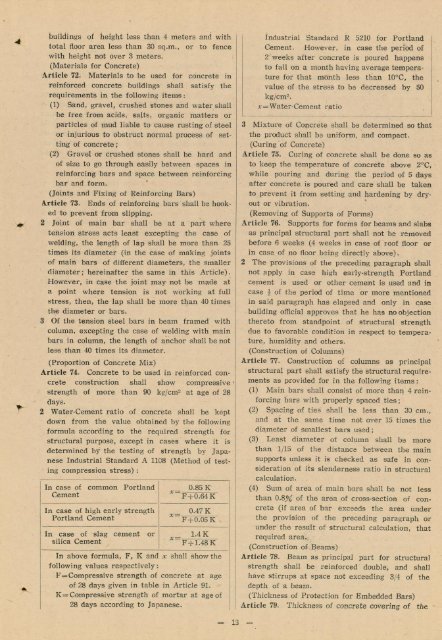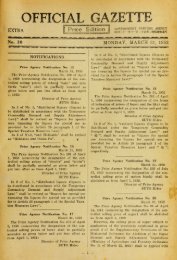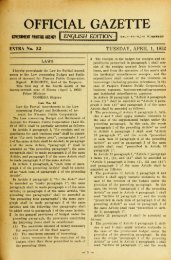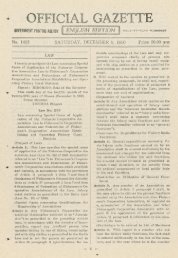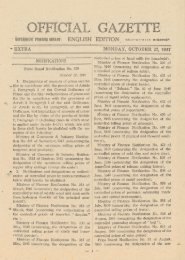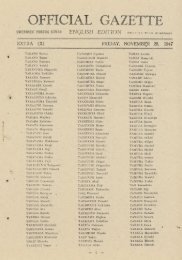OFFICIAL GAZETTE
OFFICIAL GAZETTE
OFFICIAL GAZETTE
Create successful ePaper yourself
Turn your PDF publications into a flip-book with our unique Google optimized e-Paper software.
uildings of height less than 4 meters and with<br />
total floor area less than 30 sq.m., or to fence<br />
with height not over 3 meters.<br />
(Materials for Concrete)<br />
Article 72. Materials to be used for concrete in<br />
reinforced concrete buildings shall satisfy the<br />
requirements in the following items :<br />
(1) Sand, gravel, crushed stones and water shall<br />
be free from acids, salts, organic matters or<br />
particles of mud liable to cause rusting of steel<br />
or injurious to obstruct normal process of setting<br />
of concrete;<br />
(2) Gravel or crushed stones shall be hard and<br />
of size to go through easily between spaces in<br />
reinforcing bars and space between reinforcing<br />
bar and form.<br />
(Joints and Fixing of Reinforcing Bars)<br />
Article 73. Ends of reinforcing bars shall be hooked<br />
to prevent from slipping.<br />
2 Joint of main bar shall be at a partwhere<br />
tension stress acts least excepting the case of<br />
welding, the length of lap shall be more than 25<br />
times its diameter (in the case of making joints<br />
of main bars of different diameters, the smaller<br />
diameter; hereinafter the same in this Article).<br />
However, in case the joint may not be made at<br />
a point where tension is not working at full<br />
stress, then, the lap shall be more than 40 times<br />
the diameter or bars.<br />
3 Of the tension steel bars in beam framed with<br />
column, excepting the case of welding with main<br />
bars in column, the length of anchor shall benot<br />
less than 40 times its diameter.<br />
(Proportion of Concrete Mix)<br />
Article 74. Concrete to be used in reinforced concrete<br />
construction shall show compressive•E<br />
strength of more than 90 kg/cm2 at age of 28<br />
days.<br />
2 Water-Cement ratio of concrete shall be kept<br />
down from the value obtained by the following<br />
formula according to the required strength for<br />
structural purpose, except in cases where it is<br />
determined by the testing of strength by Japanese<br />
Industrial Standard A 1108 (Method of testing<br />
compression stress) :<br />
In case of<br />
Cement<br />
commonPortland<br />
In case of high early strength<br />
Portland Cement<br />
In case of slag cement or<br />
silica Cement<br />
0.85 K<br />
"F+0.64 IT<br />
0.47 K<br />
"F+0.05K<br />
1.4K<br />
"F+1.48K<br />
In above formula, F, K and x shall showthe<br />
following values respectively :<br />
F=Compressive strength of concrete at age<br />
of28 days given in table in Article 91.<br />
K=Compressive strength of mortar at age of<br />
28 days according to Japanese.<br />
Industrial Standard R 5210 for Portland<br />
Cement. However, in case the period of<br />
2 weeks after concrete is poured happens<br />
to fall on a month having average temperature<br />
for that month less than 10°C, the<br />
value of the stress to be decreased by 50<br />
kg/cm2.<br />
x-Water-Cement ratio<br />
3 Mixture of Concrete shall be determined so that<br />
the product shall be uniform, and compact.<br />
(Curing of Concrete)<br />
Article 75. Curing of concrete shall be done so as<br />
to keep the temperature of concrete above 2°C,<br />
while pouring and during the period of 5 days<br />
after concrete is poured and care shall be taken<br />
to prevent it from setting and hardening by dryout<br />
or vibration.<br />
(Removing of Supports of Forms)<br />
Article 76. Supports for forms for beams and slabs<br />
as principal structural part shall not be removed<br />
before 6 weeks (4 weeks in case of roof floor or<br />
in case of no floor bsing directly above).<br />
2 The provisions of the preceding paragraph shall<br />
not apply in case high early-strength Portland<br />
cement is used or other cement is used and in<br />
case } of the period of time or more mentioned<br />
in said paragraph has elapsed and only in case<br />
building official approves that he has no objection<br />
thereto from standpoint of structural strength<br />
due to favorable condition in respect to temperature,<br />
humidity and others.<br />
(Construction of Columns)<br />
Article 77. Construction of columns as principal<br />
structural part shall satisfy the structural requirements<br />
as provided for in the following items :<br />
(1) Main bars shall consist of more than 4 reinforcing<br />
bars with properly spaced ties ;<br />
(2) Spacing of ties shall be less than 30 cm.,<br />
and at the same time not over 15 times the<br />
diameter of smallest bars used ;<br />
(3) Least diameter of column shall be more<br />
than 1/15 of the distance between the main<br />
supports unless it is checked as safe in consideration<br />
of its slenderness ratio in structural<br />
calculation.<br />
(4) Sum of area of main bars shall be not less<br />
than 0.8% of the area of cross-section of concrete<br />
(if area of bar exceeds the area under<br />
the provision of the preceding paragraph or<br />
under the result of structural calculation, that<br />
required area,,<br />
(Construction of Beams)<br />
Article 78. Beam as principal part for structural<br />
strength shall be reinforced double, and shall<br />
have stirrups at space not exceeding 3/4 of the<br />
depth of a beam.<br />
(Thickness of Protection for Embedded Bars)<br />
Article 79. Thickness of concrete covering of the<br />
-13-


